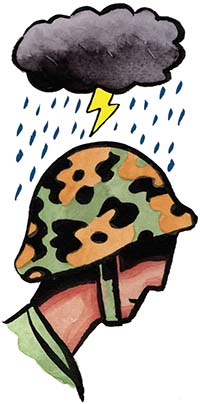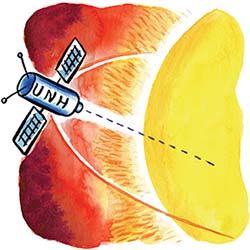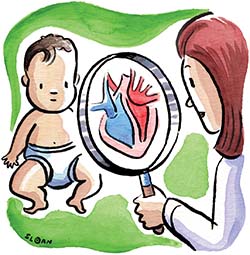 |
 |
| current issue |  | past issues |  | send a letter/news |  | address update |  | advertise |  | about us |  | alumni home |
|
Inquiring Minds By David Brooks and Virginia Stuart '75, '80G Illustrations by Michael Sloan |
Easy to print version |
In this issue:
Invisible WoundsSun-Struck
Tiny Hearts
Invisible Wounds
Does PTSD need to be redefined?
America's wars in Iraq and Afghanistan may be ending, but thousands of returning veterans still face a long struggle against depression, panic attacks, flashbacks, and other symptoms of post-traumatic stress disorder. Laurence French '68, '70G, '75G, senior research associate at UNH Justiceworks, says we don't know the half of it. In 2012, for example, the Department of Veterans Affairs found that 22 veterans had committed suicide every day during the previous two years—a 20 percent increase over a 2007 study. Most of them were men age 50 or older. In 2012, Defense Department statistics show, 349 members of the military committed suicide—more than the number killed in action (295) for the same period in Afghanistan. French has another startling statistic: "Most of the suicides of veterans, including Marines, are by people who did not serve in a combat situation."
In other words, PTSD doesn't strike just the obvious people in the obvious circumstances, and it doesn't end when combat does. A former Marine and clinical psychologist who works with traumatic-stress clients, French has argued for years that what he prefers to call "war trauma" is far more extensive than we realize and requires a renewed effort to identify and help its victims. And he believes the situation has been getting worse.

|
French says war trauma has become prevalent among Americans partly because of the extensive use of National Guard and reserve troops, who are less prepared for combat; partly because of increasing numbers of women military personnel, who could face not only stresses related to combat but also sexual assault and harassment by colleagues; and partly because of the unusual nature of post-Cold War combat, in which roadside bombs and suicide bombers are an ever-present threat. "If you're in a crisis situation, if it's quick, that is probably cathartic," he says. "It is devastating, but it isn't as devastating as the subtle process of never knowing what is going to happen next."
Also overlooked is what might be called second-hand PTSD—the effect it has on the relatives and loved ones of suffering fighters. As a Fulbright Scholar in Bosnia-Herzegovina in 2009-10, French surveyed high school students in Bosnia and Serbia in collaboration with two Balkan researchers. They found that the children of people who had suffered from untreated PTSD brought on by the Balkan War were more likely to have problems with substance abuse, violence, and delinquency than other teens.
A Marine for six years, French served during the Algerian Crisis and the 1961 evacuation of Cuba. When he taught sociology at Western Carolina University in the early 1970s, he saw many of the veterans just coming out of Vietnam whose post-combat struggles led to the first recognition of PTSD, and as a result he became a faculty adviser to veterans' organizations. Since 1980, he has been working as a psychologist for veterans while continuing to serve as a professor or visiting scholar at institutions from New Mexico to Sarajevo to St. Thomas. In 2003, he came to UNH.
French's research has resulted in numerous publications, including his 2012 book War Trauma and its Aftermath: An International Perspective on the Balkan and Gulf Wars, in which he and collaborator Lidija Nikolic-Novakovic, a Balkan War survivor, discuss how the multifaceted combat that followed the breakup of Yugoslavia and the "asymmetrical warfare" of the Gulf War have expanded the impact of combat trauma.
"We have a limited, narrow perspective of PTSD," says French, who isn't happy that the next edition of the American Psychiatric Association's Diagnostic and Statistical Manual of Mental Disorders, due out this year, is likely to make few changes in the definition of the disorder. "It should be seen on a continuum. If people can understand that, they can prevent it from getting to the most serious form."
A more honest examination of the problem, he believes, can lead to more effective treatment and help via long-term therapy, if not always a cure. Treatment includes medications for depression, anxiety, and sleep disorders. "Most important is education about the condition and symptom management for both the veteran and his or her close friends and family," says French. "There are options. The thing is, do we exercise them?" Since an estimated 2.5 million Americans will have served in one capacity or another in Iraq and Afghanistan during those decade-long wars, that's a question worth asking.
—David Brooks
Sun-Struck
Preparing for a solar close-up.
Imagine working for decades without knowing whether your efforts will produce any results. That's the norm in space science, as astrophysicist Antoinette "Toni" Galvin knows full well. She leads a UNH space science team developing a specialized telescope for studying the sun close up. In this case, preparation began in 2007 for a proposal that was first submitted in 2008. If all goes well, the satellite with the telescope will launch in 2017, and the most important data won't arrive for another six years. "It's a long lead time," says Galvin. "But it will be worth it."

|
The UNH team, including space physicist and Space Science Center director Lynn Kistler and a host of engineers, is collaborating with five other institutions to create the Ion Composition Time-of-Flight/Energy Telescope, which will be part of the upcoming American-European Solar Orbiter mission. The satellite will orbit the sun 24 times, propelled by gravity assists from the planet Venus, each time getting closer and closer, to gather unprecedented insight into the solar wind, the million-mile-per-hour blast of solar ions and electrons that shapes the earth's magnetosphere. The orbiter will even "co-rotate" with the sun, hovering over one spot for 20 days, which has never been attempted before. "The main thing," says Galvin, "is that we're going closer to the sun than any previous mission," only 21 million miles away. That's close enough to fry electronics.
UNH is responsible for the detector, roughly the size of a gallon and a half of milk, at the heart of the instrument, where the solar wind will be measured. Two different heat shields are being designed to protect the satellite and the instrument itself from vast heat—expected to reach more than 1000 degrees Fahrenheit.
Design, construction, and testing of the instrument are taking place throughout four floors of Morse Hall, using the Space Science Center's machine shop, electrical fabrications, and assembly area. "The real work is being done by the engineering staff," says Galvin. "We come up with the ideas, and then they have to work their magic to make it happen."
—David Brooks
Tiny Hearts
Education and coordination can save lives.
Every year nearly 300 American newborns are sent home from hospitals and birthing facilities with undiagnosed life-threatening heart defects. Four years ago in Indiana, one of these babies turned blue and died in her mother's arms while nursing. The child was 5 days old. Most of the infants who survive wind up back in the hospital in critical condition and may face lifelong disability.
If Monica McClain has her way, systems will soon be in place to screen every newborn in Maine, New Hampshire, Vermont, Rhode Island, and Connecticut for this hidden threat. A research associate professor at UNH's Institute on Disability, McClain is the director of a three-year project, funded with a $900,000 federal grant, that is designed to help the five states establish, assess, and maintain the infrastructure needed to screen each newborn for seven of the heart defects collectively known as critical congenital heart disease, or CCHD.

|
Every one of the seven defects can be detected with an inexpensive, noninvasive test called pulse oximetry, in which a small bandage is placed on the baby's hand and foot for five minutes. The defects can be treated with surgery, often with very good results. Although New Hampshire and Connecticut have recently mandated testing, they still lack the systems—including the education of doctors, collection of statistics, assessment of outcomes, and coordination with neighboring states—to ensure consistent and effective results. Vermont has yet to begin testing, and Maine and Rhode Island have just begun the process.
One significant accomplishment of the project's first year is the completion of an educational brochure produced with the help of parent focus groups. The parents urged the researchers to include a photo of a baby undergoing pulse oximetry, for example, to show that the procedure is noninvasive. The most important accomplishment so far, however, is this: Three newborns tested positive—and received further evaluation and treatment before they left the hospital. ~
—Virginia Stuart '75, '80G
blog comments powered by Disqus

